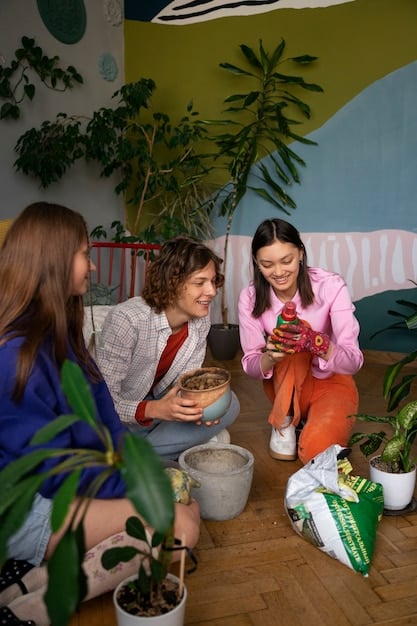Sustainable Living on a Budget: Save Money & Reduce Impact 2025

Living sustainably on a budget in 2025 means strategically integrating eco-friendly practices into daily life that not only lessen environmental impact but also yield significant financial savings through mindful consumption, energy efficiency, and waste reduction.
In a world increasingly focused on both financial prudence and ecological responsibility, finding harmony between the two often feels like a distant dream. Yet, the pursuit of sustainable living on a budget: save money and reduce your environmental impact in 2025 is not only achievable but becoming an essential mindset for many households. This approach transforms everyday choices into powerful acts of preservation and economic empowerment.
Embracing a Mindset of Conscious Consumption
The foundation of sustainable living, particularly when budget-conscious, lies in a fundamental shift in perception: moving away from relentless consumption towards a more mindful, intentional approach. This isn’t about deprivation, but rather about reimagining how we acquire and use resources in ways that benefit both our wallets and the planet. By understanding the true cost of our habits, we can make choices that actively reduce financial strain while minimizing our ecological footprint.
Rethinking Our Relationship with “New”
One of the most immediate financial and environmental wins comes from challenging the ingrained habit of buying new. The production of new goods, from electronics to clothing, demands vast amounts of energy, water, and raw materials, often generated through environmentally damaging processes. Opting for second-hand items not only saves money but also extends the lifecycle of products, keeping them out of landfills and reducing the demand for new production. This practice supports a circular economy, where resources are reused and recycled, rather than being discarded after a single use.
Consider the myriad of items that can be purchased pre-owned: furniture, books, tools, and even clothing. Online marketplaces, thrift stores, and community groups offer abundant opportunities to find quality items at a fraction of their original cost. The beauty of this approach is that it often uncovers unique, character-filled pieces that couldn’t be found elsewhere, adding a personal touch to your home or wardrobe without the environmental baggage.
- Explore local thrift stores and consignment shops.
- Utilize online marketplaces for second-hand goods.
- Organize or participate in community swap events.
- Prioritize repairing items over replacing them when possible.
The Power of “Reduce, Reuse, Recycle, Repair”
While recycling has long been the cornerstone of environmental efforts, the true hierarchy of sustainable practices begins with reduction and reuse. Reducing consumption at its source is the most impactful step, as it prevents waste and the resources needed to create disposables. This means saying no to single-use plastics, opting for durable alternatives, and investing in items that are built to last rather than designed for obsolescence.
Reuse extends the life of products beyond their initial purpose, transforming waste into resource. Consider repurposing glass jars for food storage, using old fabrics as cleaning rags, or finding creative uses for packaging. When items do reach their end-of-life, recycling ensures that valuable materials can be fed back into the production cycle, rather than ending up in landfills. This practice, coupled with a growing repair culture, creates a robust framework for budget-friendly sustainability, reducing both expenses and ecological damage.
Embracing conscious consumption is a journey that can significantly save money and reduce your environmental impact. It begins with small, deliberate choices that collectively lead to a more sustainable and financially responsible lifestyle, proving that eco-friendly habits are deeply intertwined with economic well-being.
Transforming Your Home into an Eco-Efficient Haven
The home is a primary nexus for both environmental impact and financial expenditure. From energy consumption to water usage, the way we manage our living spaces directly influences our carbon footprint and utility bills. By implementing strategic eco-efficient upgrades and habits, a budget-conscious approach can turn your home into a beacon of sustainability, yielding long-term savings and a healthier living environment.
Optimizing Energy Use: Lighting and Appliances
Energy is often one of the largest household expenses, and much of it is used inefficiently. Simple changes in lighting can make a significant difference. Replacing traditional incandescent bulbs with LED (Light Emitting Diode) bulbs is a prime example. While LEDs have a higher upfront cost, their longevity (often lasting 25 times longer) and remarkable energy efficiency (using 75% less energy) translate into substantial savings over time. Furthermore, remembering to turn off lights when leaving a room, and maximizing natural light during the day, are free habits that further reduce consumption.
When it comes to appliances, the key is understanding their energy demands. Older appliances tend to be energy hogs. While replacing them might seem like a significant outlay, investing in ENERGY STAR® certified models can dramatically cut electricity usage. These appliances are designed to be highly energy-efficient, and over their lifespan, the savings on utility bills often outweigh the initial purchase cost. Prioritizing efficient use also matters: running washing machines and dishwashers only when full, and unplugging electronics when not in use (to combat “vampire drain”) are practical ways to save without large investments.

Water Conservation: Smart Habits and Simple Upgrades
Water, an increasingly precious resource, also plays a significant role in household expenses and environmental impact. Reducing water consumption doesn’t always require costly plumbing overhauls. Simple, mindful habits can have a profound effect. Taking shorter showers, turning off the tap while brushing teeth or washing dishes, and fixing leaks promptly are fundamental practices that save gallons. Leaky faucets and toilets can waste thousands of gallons of water annually, translating directly into higher water bills and unnecessary resource depletion.
For those willing to make small investments, low-flow showerheads and faucet aerators are inexpensive upgrades that significantly reduce water usage without compromising water pressure. Collecting rainwater for gardening or car washing is another effective and free way to conserve potable water. These combined efforts create a comprehensive approach to water conservation, demonstrating that eco-efficiency at home is well within reach for those mindful of their budget.
- Install low-flow showerheads and faucet aerators.
- Fix leaky faucets and toilets immediately.
- Take shorter showers.
- Collect rainwater for outdoor uses like gardening.
By thoughtfully addressing energy and water consumption within the home, individuals can make substantial strides in sustainable living. These changes not only result in lower utility bills but also contribute to a healthier planet, proving that small adjustments in household management can have a significant collective impact.
Sustainable Food Choices: Eating Well and Responsibly
The food we consume has a pervasive impact on our finances, our health, and the environment. Making sustainable food choices isn’t just about what we eat, but how it’s produced, transported, and ultimately, how much of it goes to waste. A budget-friendly approach to sustainable eating focuses on minimizing waste, supporting local systems, and making informed decisions that benefit both the planet and your pantry.
Minimizing Food Waste: From Kitchen to Compost
Food waste is an enormous problem, contributing to significant financial losses for households and generating potent greenhouse gases in landfills. The average family in the US wastes about 25% of the food they buy, which equates to hundreds of dollars annually. Preventing this waste starts with thoughtful planning. Creating a meal plan for the week and making a shopping list based on that plan can help avoid impulse purchases and ensure that ingredients are used before they spoil.
Proper food storage is another critical component. Understanding how to store different types of produce and leftovers can extend their shelf life. Utilizing every part of an ingredient, like making vegetable broth from scraps or using overripe fruit for smoothies, also helps. For unavoidable food scraps, composting transforms organic waste into nutrient-rich soil, diverting it from landfills. This practice not only reduces emissions but also offers a free, natural fertilizer for home gardens, closing the loop on food use.
Embracing Plant-Based Meals and Local Produce
While a complete dietary overhaul isn’t necessary for everyone, incorporating more plant-based meals can significantly reduce both grocery bills and environmental impact. Meat production is resource-intensive, requiring vast amounts of land and water, and contributing substantially to greenhouse gas emissions. Legumes, grains, and seasonal vegetables often cost less per serving and offer abundant nutritional value. Experimenting with “meatless Mondays” or fully transitioning to a plant-forward diet can yield significant savings over time.
Shopping for local and seasonal produce also offers multiple benefits. It typically means fresher, tastier food available at lower prices, as it avoids the costs associated with long-distance transportation and storage. Buying directly from farmers or at farmers’ markets supports local economies and reduces the carbon footprint associated with your food. Furthermore, seasonal eating encourages a varied diet and reconnection with natural cycles of food production, making sustainable choices more accessible and enjoyable.
- Plan meals and use shopping lists to reduce impulse buys.
- Store food properly to extend its freshness.
- Compost vegetable scraps and food waste.
- Incorporate more plant-based meals into your diet.
By making conscious choices about what and how we eat, individuals can lead a more sustainable lifestyle that simultaneously reduces financial strain. These efforts contribute to a healthier planet and a more resilient food system for all.
Eco-Friendly Transportation: Moving with Purpose
Transportation is one of the most significant contributors to an individual’s carbon footprint and often represents a considerable portion of household expenses. Adopting eco-friendly transportation habits not only lessens environmental impact but also offers substantial financial savings. This sector presents numerous opportunities for sustainable living on a budget, shifting from reliance on fossil fuels to more sustainable alternatives for commuting and travel.
Walking, Biking, and Public Transit
The simplest and most cost-effective forms of eco-friendly transport are often the most overlooked: walking and biking. For short distances, these options eliminate fuel costs, reduce vehicle wear and tear, and offer the added benefit of physical activity. Committing to walking or cycling for errands, commutes, or leisure trips can significantly reduce monthly spending on gas and vehicle maintenance. Beyond personal savings, these modes of transport reduce traffic congestion and air pollution, contributing to healthier communities.
When distances are too great for walking or biking, public transportation emerges as an excellent alternative. Buses, trains, and subways, especially in urban areas, can move large numbers of people efficiently, significantly reducing individual carbon emissions compared to single-occupancy vehicles. While there is a fare, the cumulative cost is often far less than owning and operating a car, factoring in gas, insurance, parking, and maintenance. Many cities offer monthly passes or discounted fares, making public transit an even more attractive option for budget-conscious individuals.
Smart Car Use: Carpooling and Electric Vehicles
For situations where a personal vehicle is unavoidable, making smart choices about car use can still align with sustainable and budget-friendly goals. Carpooling, whether with colleagues, friends, or through ride-sharing applications, reduces the number of cars on the road, cutting fuel costs for all participants and lowering collective emissions. This is an immediate and effective strategy to share resources and reduce individual impact without significant investment.
Looking ahead, the shift towards electric vehicles (EVs) represents a more substantial but increasingly viable sustainable transportation solution. While the upfront cost of an EV can be higher, government incentives, lower fuel costs (electricity is generally cheaper than gasoline), and reduced maintenance (fewer moving parts) often lead to significant long-term savings. As battery technology improves and charging infrastructure expands, EVs are becoming an even more attractive option for those committed to reducing their environmental footprint and fuel expenses. For those with older, less efficient cars, even driving habits like avoiding rapid acceleration and maintaining proper tire pressure can improve fuel economy.

Shifting transportation habits is a gradual process that can lead to substantial financial savings and a healthier planet. By prioritizing active transport, utilizing public systems, and making mindful choices about car use, individuals contribute to a greener future while keeping their budgets intact.
Reducing Waste in Daily Life: Beyond the Bin
Waste generation is a relentless issue, with households constantly discarding items that end up in landfills, contributing to pollution and resource depletion. A truly sustainable lifestyle on a budget goes far beyond simply recycling; it embraces a holistic approach to waste reduction, preventing items from becoming waste in the first place. This strategy is inherently budget-friendly as it emphasizes consuming less and making the most of what you have.
Reusable Alternatives: The Everyday Swap
One of the most effective ways to reduce daily waste and save money is by switching from single-use items to reusable alternatives. Consider the sheer volume of plastic bags, coffee cups, water bottles, and take-out containers that pass through our hands daily. Each of these represents a cost – both to the consumer and to the environment – and quickly accumulates in landfills. Investing in durable, reusable versions of these items is a simple yet powerful change.
A high-quality reusable water bottle, for instance, eliminates the need to buy bottled water, saving hundreds of dollars annually and preventing countless plastic bottles from being produced and discarded. Similarly, carrying a reusable coffee cup to cafes often comes with a discount, further incentivizing its use. Reusable shopping bags are now commonplace, but extending the concept to produce bags, washable cloths instead of paper towels, and even reusable menstrual products can lead to significant long-term financial and environmental gains. While there’s an initial outlay, the savings rapidly accumulate as you eliminate repeated purchases of disposable goods.
DIY and Upcycling: Creativity Meets Economy
Embracing a do-it-yourself (DIY) philosophy and the art of upcycling can turn potential waste into valuable resources, all while saving money. Instead of buying new cleaning products laden with chemicals and packaged in plastic, consider making your own with simple ingredients like vinegar, baking soda, and essential oils. These homemade solutions are often cheaper, safer, and equally effective, demonstrating that sustainability doesn’t require expensive specialized products.
Upcycling takes this concept a step further by transforming discarded items into something new and useful, adding unique character to your home without purchasing new goods. An old wooden pallet can become a stylish coffee table, glass jars can be repurposed for food storage or decorative vases, and worn-out clothing can be turned into cleaning rags or craft materials. This creative approach to resource management not only reduces landfill waste but also fosters a sense of self-sufficiency and ingenuity, proving that waste can be a resource in disguise for the budget-conscious individual.
- Swap single-use items for reusable alternatives (bottles, bags, cups).
- Make your own cleaning products from natural ingredients.
- Upcycle old items to create new furniture or decor.
- Compost food scraps to reduce landfill waste.
By consciously choosing reusability and embracing creativity in resource management, individuals can significantly reduce their daily waste output. These practices offer a tangible pathway to a more sustainable and economically sound lifestyle, moving beyond mere recycling to truly prevent waste at its source.
Conscious Shopping: Beyond the Price Tag
In the pursuit of sustainable living on a budget, conscious shopping emerges as a critical skill. It involves looking beyond the immediate price tag to consider the full lifecycle cost of a product – its environmental impact, ethical production, and durability. This approach helps consumers make informed decisions that align with both their financial goals and their commitment to sustainability, fostering a deeper understanding of value over momentary savings.
Quality Over Quantity: Investing in Durability
The allure of cheap, disposable goods is strong, but they often represent a false economy. Products designed for obsolescence, whether clothing, electronics, or household items, quickly wear out, requiring frequent replacement. This cycle not only drains your budget over time but also contributes to massive amounts of waste. A conscious shopping strategy prioritizes quality over quantity, investing in durable products that are built to last.
While a high-quality item might have a higher upfront cost, its longevity often means it needs to be replaced far less frequently, resulting in significant long-term savings. For instance, a well-made pair of shoes, though more expensive initially, could outlast several pairs of cheaper alternatives. This principle applies across categories, from appliances to furniture. When shopping, research brands known for their reliability and look for warranties that signal a manufacturer’s confidence in their product. Choosing products that can be repaired, rather than simply discarded, further extends their lifespan and enhances their value, reducing both environmental impact and future expenses.
Supporting Ethical and Sustainable Brands
Conscious shopping also extends to supporting brands that actively prioritize ethical labor practices and environmental sustainability. This might seem like a luxury for a budget-conscious consumer, but many companies are increasingly offering sustainable options at competitive price points, recognizing growing consumer demand. Beyond the obvious environmental benefits, supporting these brands contributes to a more responsible global economy.
Researching a company’s production processes, sourcing of materials, and labor conditions can provide valuable insights. Look for certifications such as Fair Trade, GOTS (Global Organic Textile Standard), or B Corp status, which indicate a commitment to higher social and environmental standards. While these products may sometimes carry a slightly higher cost, they embody values that often translate into better quality and a longer lifespan, thereby offering long-term value. Furthermore, supporting these businesses sends a powerful message to the market, encouraging more companies to adopt sustainable practices, ultimately making ethical choices more widely available and affordable for everyone.
- Prioritize buying durable, long-lasting products.
- Research brands for their ethical and environmental practices.
- Look for products with fair trade or sustainability certifications.
- Consider the long-term value of an item over its immediate price.
By engaging in conscious shopping, consumers can make purchasing decisions that are both economically prudent and environmentally responsible. It’s about valuing longevity, ethical production, and the true cost of goods, transforming every purchase into an investment in a more sustainable future.
Building Community and Knowledge for a Sustainable Future
Sustainable living, particularly when navigating it on a budget, is not a solitary endeavor. It thrives within a supportive network of shared knowledge, collective action, and community engagement. By connecting with like-minded individuals and continually expanding one’s understanding, the pursuit of an eco-friendly and financially resilient lifestyle becomes more accessible, enjoyable, and impactful.
Learning and Sharing: Workshops and Online Resources
Knowledge is a powerful tool in sustainable living. There is a wealth of information available, from practical DIY guides to in-depth research on environmental issues. Engaging with this knowledge base empowers individuals to make informed decisions and discover new, budget-friendly ways to reduce their impact. Online platforms, blogs, and documentaries offer a vast repository of free information, covering everything from home composting techniques to efficient energy use.
Beyond individual research, participating in workshops or local community events provides invaluable hands-on learning opportunities and a chance to connect with experts and peers. Many local libraries, community centers, or environmental organizations offer free or low-cost workshops on topics such as urban gardening, zero-waste living, or repairing household items. These sessions not only teach practical skills but also foster a sense of shared purpose, making the journey towards sustainability less daunting and more communal.
Community Engagement and Local Initiatives
The power of collective action cannot be overstated. Engaging with local initiatives and community groups amplifies individual efforts and creates broader systemic change. Community gardens, for example, offer a space for shared food production, reducing grocery bills and promoting local food security. Tool libraries allow members to borrow rather than buy infrequently used items, saving money and reducing consumption. Repair cafes encourage fixing items together, extending product lifespans and reducing waste.
Beyond formal groups, simply sharing tips and experiences within your social circles can inspire others and build a supportive environment. Organizing or participating in community swap meets for clothing, books, or household goods can reduce waste and provide valuable items for free. Advocating for sustainable policies at the local level, such as improved recycling programs or public transport infrastructure, contributes to creating a more eco-friendly community for everyone, demonstrating that individual actions combined with community efforts can drive significant change.
- Utilize free online resources and educational platforms.
- Participate in local sustainable living workshops.
- Join community gardens or volunteer for environmental causes.
- Share sustainable living tips and ideas with friends and family.
Embracing community and continuously seeking knowledge transforms sustainable living from a personal challenge into a collaborative journey. It reinforces the idea that an eco-friendly, budget-conscious future is built on shared learning, mutual support, and collective action, proving that together, we can achieve more for both our finances and the planet.
| Key Area | Brief Description |
|---|---|
| 🛒 Conscious Consumption | Prioritize second-hand, repair, and reduce waste to save money and resources. |
| 💡 Eco-Efficient Home | Implement energy-saving lights & appliances, and conserve water to cut utility bills. |
| 🍽️ Sustainable Food | Reduce food waste, embrace plant-based meals, and buy local to save money and impact. |
| 🚶♂️ Green Transportation | Walk, bike, use public transit, or carpool to reduce fuel costs and emissions. |
Frequently asked questions about sustainable living
▼
Not necessarily. While some eco-friendly products might have higher upfront costs, sustainable living often leads to significant long-term savings. Practices like reducing waste, conserving energy, buying second-hand, and making homemade products directly reduce daily expenses and utility bills, proving that sustainability can be budget-friendly.
▼
Begin with simple habits that require no investment, such as unplugging electronics, taking shorter showers, and meal planning to reduce food waste. Gradually introduce reusable items like water bottles and shopping bags. Prioritize basic actions like walking or biking, and opt for repairing rather than replacing items whenever possible.
▼
Key areas for savings include energy consumption (LEDs, unplugging), water usage (low-flow fixtures, shorter showers), food (reducing waste, plant-based meals, cooking at home), and transportation (walking, biking, public transit). These areas offer the most direct opportunities to reduce expenses while positively impacting the environment.
▼
Yes, buying second-hand is highly sustainable. It extends the life of products, reduces demand for new manufacturing—which consumes raw materials and energy—and diverts items from landfills. This practice supports a circular economy, significantly lessening environmental impact and saving you money compared to buying new.
▼
Lead by example and share your positive experiences, especially the financial benefits. Offer practical tips and resources, participate in community initiatives, and engage in open, non-judgmental conversations. Focus on the ease and benefits of small changes rather than emphasizing radical shifts, making sustainable living feel accessible and appealing.
Conclusion
Navigating the path toward sustainable living on a budget in 2025 is not merely an idealistic endeavor but a pragmatic strategy that intertwines personal financial well-being with environmental responsibility. As explored, myriad opportunities exist, from conscious consumption and eco-efficient home management to sustainable food choices and greener transportation, all culminating in substantial monetary savings alongside a reduced ecological footprint. By embracing a mindset of mindful living, valuing durability over disposability, and actively engaging with community resources, individuals can systematically transform their daily habits into powerful acts of preservation and economic empowerment. This journey demonstrates that a greener, more resilient future is not only attainable but also financially advantageous, proving that harmony between pocket and planet is well within reach.





